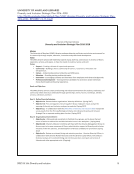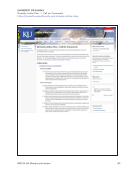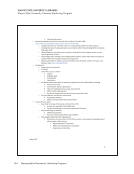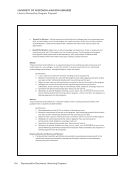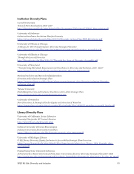106 Representative Documents: Institution Diversity Goals, Values, Statements
CORNELL UNIVERSITY
Toward New Destinations 2016–2017. Appendix: University Goals Structures
http://diversity.cornell.edu/sites/default/files/documents/TND 2016 Appendix doc final.pdf
8
3. Measurements and Standards
Assumptions and Standards
• The concept of “diversity” extends well beyond race and sex, and the
university is committed to collecting and disseminating a greater variety of
diversity data in addition to these categories, but in reflection of our legal
obligations to collect and report data about race and sex, metrics relating to
these specific concepts are very commonly used.
• While it may be important to describe the actions a unit has undertaken
pursuant to a given diversity initiative, assessment should rely primarily on
data from or about constituent populations.
• Wherever possible, the efficacy of diversity initiatives should be assessed
in light of centrally-maintained institutional data and widely-accepted
definitions of key concepts, systematically measured and contextualized.
This practice facilitates internal comparisons (such as across units at Cornell)
and external bench-marking (such as with peer universities).
• It most cases, comparisons should be made as percentages and with
reference to the populations and pools most relevant to a given constituency.
Institutional Support and Unit Responsibility
• The public Diversity Dashboard and the secured-access Executive
Diversity Dashboard are resources that facilitate the examination of
diversity by sex and race/ethnicity among Cornell constituencies.
• While there are centralized resources (such as Institutional Research &
Planning and the Department of Inclusion &Workforce Diversity) that may
CORNELL UNIVERSITY
Toward New Destinations 2016–2017. Appendix: University Goals Structures
http://diversity.cornell.edu/sites/default/files/documents/TND 2016 Appendix doc final.pdf
8
3. Measurements and Standards
Assumptions and Standards
• The concept of “diversity” extends well beyond race and sex, and the
university is committed to collecting and disseminating a greater variety of
diversity data in addition to these categories, but in reflection of our legal
obligations to collect and report data about race and sex, metrics relating to
these specific concepts are very commonly used.
• While it may be important to describe the actions a unit has undertaken
pursuant to a given diversity initiative, assessment should rely primarily on
data from or about constituent populations.
• Wherever possible, the efficacy of diversity initiatives should be assessed
in light of centrally-maintained institutional data and widely-accepted
definitions of key concepts, systematically measured and contextualized.
This practice facilitates internal comparisons (such as across units at Cornell)
and external bench-marking (such as with peer universities).
• It most cases, comparisons should be made as percentages and with
reference to the populations and pools most relevant to a given constituency.
Institutional Support and Unit Responsibility
• The public Diversity Dashboard and the secured-access Executive
Diversity Dashboard are resources that facilitate the examination of
diversity by sex and race/ethnicity among Cornell constituencies.
• While there are centralized resources (such as Institutional Research &
Planning and the Department of Inclusion &Workforce Diversity) that may


















































































